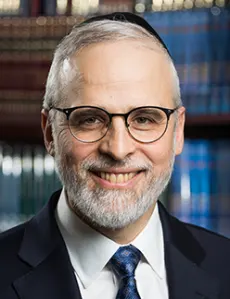In today’s horribly fractured political climate in both America and Israel, we need leadership that understands that there is nothing as divisive as winning.
Every triumph produces a loser. That was why Moshe’s brother Aaron consistently guided people to avoid courtroom battles and pursue compromise (Sanhedrin 6b). Aaron, whose life was dedicated to the love and pursuit of peace (Pirkei Avot 1:12), knew that the outcome of a court case would be joyous triumph for one and disappointing or even devastating loss for the other, driving the parties further apart, whereas compromise – where there is now winner or loser – can produce peaceful reconciliation.
Maharal of Prague noted that Aaron’s role as the kohein gadol (High Priest) required him to love and pursue peace. There is an old and tired Jewish joke about the man marooned on a desert island who was finally rescued. As he showed the newcomers around the island that had been his home for years, they were surprised to see that he had built two shuls. “This one,” he explained, “is the shul where I daven; that is the shul I would never step foot into.” While this may be the sad truth in too many of our communities, it is the very opposite of how Jewish life was meant to be structured. We were to have one temple – the mishkan or the beit hamikdash – in which we were all invested. As it was Aaron’s job to preside over that temple, he had no choice but to make it his mission to keep the peace between people, to hold them together and avoid a breakaway mishkan.
Aaron did not have to start from scratch. The mishkan was originally built at Sinai, where we had come together as one, k’ish echad b’lev echad, and it was intended to be a lasting version of that Sinai experience (see Ramban’s introduction to Terumah). It was Aaron’s mission to maintain that togetherness and therefore enable the mishkan’s lasting role as the unifying center of our people.
This idea would repeat itself at the time of the building of the beit hamikdash. There it was not the kohein but the king who undertook to unify the people. David had an immensely challenging task as he was a new king who – to put it mildly – had experienced extreme opposition from the king whose dynasty he was interrupting. Beyond the personal tension that may have been present between Shaul and David, there was also the context of the shifting of the throne from the tribe of Binyamin to the tribe of Yehuda, a shift that crossed the classic fault line within Klal Yisrael between the children of Rachel and Leah. David was now clearly the victor, but could he be the king? How could he unify this fractured nation under his leadership?
The magnificent story of how David accomplished that feat is critical for each of us to learn and review periodically. That story is told in the first five chapters of the book of Shmuel II, where it describes how David, with incredible wisdom and humility, demonstrated how he did not for one moment delight in the triumph over his predecessor and pursuer King Shaul. Instead, David grieved over Shaul’s death and opposed those who assassinated Shaul’s general, Avner. David was a true leader who understood that the winner who seeks to take all is left with nothing. His job was not to win the throne but to win over the people. Vayehi b’yeshurun melech b’hitaseif rashei am yachad shivtei Yisrael (Devarim 33:5). The Jewish people can only be governed and function as a nation when its leaders and tribes can come together and coalesce around their king.
Once David accomplished that and gained the people’s trust such that even the tribe of Binyamin came forth to accept his reign, he was prepared to move to Yerushalayim and to begin the process that would lead to the building of the Beit Hamikdash (“mikdash melech ir melucha”). It is especially noteworthy that the beit hamikdash was built straddling the geographic boundary between the tribal portions of Yehuda and Binyamin (Yoma 12a), thus representing the healing and unifying of the opposing forces within the Jewish people that was required to build that one temple that would serve them all.
One may suggest that history repeats itself yet again in the story of Purim. Esther and her uncle Mordechai – who is described as both ish Yehudi and ish Yemini, a descendant of both Yehuda and Binyamin (see Megillah 12b) – set about to unify a fractured Jewish people (yeshno am echad mefuzar umeforad; leich kenos et kol haYehudim). That unity was needed not only to save the Jewish people from the immediate threat posed by Haman’s decree, but also to set the stage for the building of the second beit hamikdash that would follow upon that victory. Thus, Megillat Esther closes by describing Mordechai’s leadership: Ratzui l’rov echav doreish tov l’amo v’doveir shalom l’chol zaro. Mordechai was a leader beloved by the multitudes of his brothers, working for the good of his nation and speaking words of peace for the benefit of all its children.
True power is used to unify. That was the source of the power that Aaron Hakohein exercised to build the mishkan, that David Hamelech used to build the first beit hamikdash, and that Mordechai Hayehudi put in place to set the stage for the second. That is true leadership, and it is what is needed now more than ever.

















